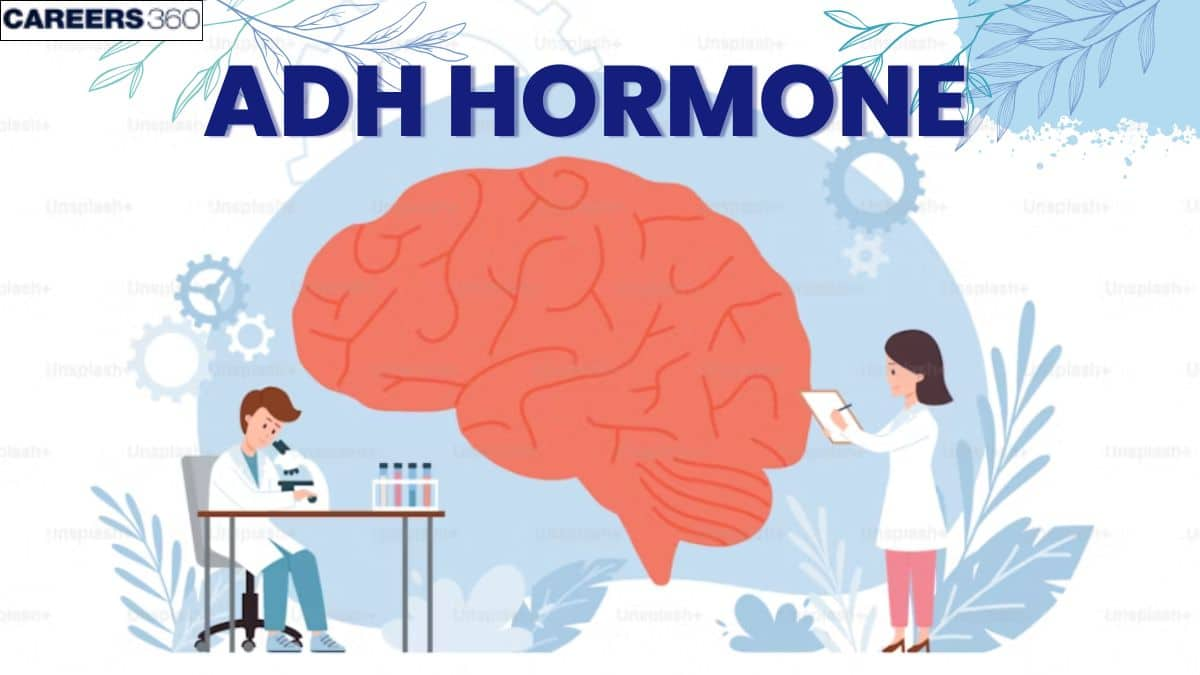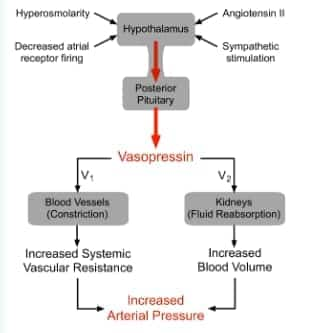Antidiuretic Hormone (ADH)
ADH hormone, or vasopressin, regulates water balance, blood pressure, and homeostasis. Learn its functions, mechanism, receptors, and related disorders with NEET-ready notes and MCQs.
This Story also Contains
- What is ADH Hormone?
- Synthesis and Storage of ADH
- Factors Affecting ADH Regulation
- Functions of ADH Hormone
- Mechanism of Action of ADH
- Effects of ADH on the Body
- Side Effects and Disorders Related to ADH
- Mnemonics For Easy Learning
- ADH in NEET, CBSE, and Paramedical Exams
- ADH Hormone NEET MCQs
- FAQs on ADH Hormone
- Recommended Video On ADH Hormone

What is ADH Hormone?
The full form of ADH is Antidiuretic Hormones. As its name implies, an antidiuretic is a substance that decreases urine production. ADH causes the kidneys to return more water to the blood, thus decreasing urine volume. In the absence of ADH, urine output increases from the normal 1 to 2 liters to about 20 liters a day. ADH also decreases the water lost through sweating and causes constriction of arterioles, which increases blood pressure. This hormone’s other name, vasopressin, reflects this effect on blood pressure.
Synthesis and Storage of ADH
Although the posterior pituitary lobe, or neurohypophysis, does not synthesize hormones, it does store and secrete two peptide hormones, namely oxytocin and vasopressin. Antidiuretic Hormone is one of the two neurohormones synthesized by the neurosecretory cells present in the hypothalamus and carried to the neurohypophysis along the nerve fibres, where it is stored along with oxytocin.
Specialized neurons of the hypothalamus with the ability to secrete known as “neurosecretory cells,” synthesize these hormones, which are then transported axonally via neurohypophysial capillaries to the posterior lobe. Thus, the antidiuretic hormone (ADH or vasopressin hormone) is secreted into the bloodstream by the posterior lobe of the pituitary gland present at the base of the brain.
Factors Affecting ADH Regulation
The release of Antidiuretic Hormone into the bloodstream is regulated by various factors. These include:
Factors | Antidiuretic Hormone release affects |
Blood pressure | It is detected by receptors present in large blood vessels and the heart which increases antidiuretic hormone secretion. |
Salt concentration | This is detected by neurosecretory cells present in the hypothalamus and hence results in increasing antidiuretic hormone secretion. |
High ADH due to medical complications | This can be due to the effects of drugs, pulmonary conditions, and, in severe cases, cancers such as leukaemia and lymphoma. |
| |
High ADH levels |
|
Functions of ADH Hormone
Some of the major functions of Antidiuretic Hormone is discussed below:
The antidiuretic hormone causes vasoconstriction and clot formation.
The antidiuretic hormone plays a significant role in regulating the biological clock.
ADH maintains the body's homeostasis, blood volume & the smooth and proper flow of urine from the kidneys.
Apart from this ADH also maintains an appropriate volume of water in the spaces surrounding the cells inside the body.
The antidiuretic hormone also aids in smooth cellular functions.
Mechanism of Action of ADH
The Antidiuretic Hormone mechanism of action can be explained as follows-
Antidiuretic Hormone exerts an antidiuretic action by enhancing the reabsorption of water from the kidneys back into circulation. Antidiuretic or vasopressin affects V1 and V2 receptors to produce its effects.
Aspect | Mechanism |
Receptor action | Acts upon V1 and V2 receptors to activate their effects. |
V2 receptors |
|
V1 receptors |
|

Effects of ADH on the Body
ADH causes constriction of blood vessels and raises blood volume or blood pressure, which is why it is called vasopressin.
Effect of Antidiuretic Hormone | Explanation |
Blood vessel constriction | It helps in increasing blood pressure and blood volume, and this results in constriction of the blood vessels. |
Contraction of smooth muscles | Helps some contracting smooth muscles of the body such as the small intestine, large intestine, gallbladder, urinary bladder, and blood vessels. |
Maintenance of homeostasis | Also helps in the maintenance of body homeostasis and proper cellular functions. |
Water reabsorption | Acts upon proximal renal tubules that are responsible for water reabsorption. Also reduces urine volume by concentrating it. |
Regulation of the circadian cycle | Antidiuretic hormone maintains the body's circadian cycle by regulating it. |
Side Effects and Disorders Related to ADH
Excess secretion of Antidiuretic Hormone can also lead to some major side effects in the body. Some of them are mentioned below:
A low level of ADH in the blood results in diabetes insipidus, where the reabsorption of water is reduced.
This results in excessive water loss through dilute urine.
Antidiuretic hormone often lowers blood pressure and increases urine volume.
Hyposecretion of ADH also causes damage to the hypothalamus and pituitary gland.
A high ADH level causes the blood to dilute and the plasma to be low in sodium.
Hypersecretion of adh can result in acute conditions with symptoms such as nausea, headache, dehydration, vomiting, etc.
A hyper or hypo secretion of ADH often results in several disorders.
These are as follows-
Insomnia
Head injuries
Delayed puberty
Frequent urination
Change in appetite etc.
Mnemonics For Easy Learning
Here are some quick tips, tricks, and strategies to remember the role of ADH (antidiuretic hormone) or vasopressin:
"Anti-diuretic" = Less Uretic
"Anti" means opposing, so ADH reduces urination by retaining water in the body.
Vasopressin = Vessel Pressure
Vasopressin is another name for ADH. It presses the blood vessels, leading to an increase in blood pressure.
Remember: Vasopressin = Vessel pressure rises.
V2 = Water Reabsorption
V2 receptors in the kidneys help in water reabsorption.
Tip: Think of H2O to remember V2's role with water.
V2 = Very Thirsty
When ADH acts on the kidneys, water is reabsorbed, reducing thirst and maintaining hydration.
ADH in NEET, CBSE, and Paramedical Exams
During preparation for different exams, students may face different questions on the topic of antidiuretic hormone
Exam type | Types of questions asked |
Definition of Antidiuretic hormones, explanation of their role, effects of adh on blood pressure, and difference between adh and other hormones. | |
Mechanism of action of Antidiuretic hormone, implications of Antidiuretic hormones, case studies related to Antidiureutic hormones disorder. | |
Paramedical Entrance Exams | Managing the disorders. |
Conclusion
As we have gone through the details of antidiuretic hormone, its action, its regulatory pathway, and clinical significance it becomes important for us to understand why it is important for our body. It is essential to recognize the implications for our health homeostasis and also the various physiological effects of ADH on our body.
ADH Hormone NEET MCQs
Q1. The Pars distalis region of the pituitary does not produce these hormones
a. Melanocyte stimulating hormone
b. Vasopressin
c. Prolactin
d. Growth hormone
I and IV
II and IV
II and III
I and II
Correct answer: 4) I and II
Explanation:
Hormones released from Posterior Lobe:
1. Oxytocin:
This hormone stimulates the contraction of smooth muscles of the uterus in pregnant women and causes easy childbirth.
It also contracts the smooth muscles of mammary glands in lactating mothers and facilitates the flow of milk at the time of suckling.
Oxytocin also stimulates the relaxation of the gallbladder, urinary bladder, and intestine.
2. Vasopressin or Antidiuretic Hormone (ADH):
The primary function of vasopressin is to increase the reabsorption of water in the distal convoluted tubules and collecting tubules of the kidney.
So its deficiency in the body increases the volume of urine causing diabetes insipidus.
This type of diabetes is different from diabetes mellitus in that the urine is free from sugar.
Another important function of ADH is to bring about the contraction of smooth muscles of the intestine, gallbladder, urinary bladder, and blood vessels.
Hence, large quantities of the hormone cause the arterial blood pressure to rise due to the contraction of peripheral arterioles.
Intake of alcohol reduces ADH secretion.
Hence, the correct answer is option 4) I and II.
Q2. Which of the following statements accurately describes the hormones produced and secreted by different parts of the pituitary gland?
A. The pars distalis is responsible for the production and release of growth hormone (GH), prolactin (PRL), thyroid-stimulating hormone (TSH), adrenocorticotropic hormone (ACTH), luteinizing hormone (LH), and follicle-stimulating hormone (FSH).
B. The pars intermedia solely secretes a single hormone known as melatonin.
C. The posterior lobe of the pituitary gland is alternatively referred to as the neurohypophysis or pars nervosa.
D. The posterior pituitary gland stores and releases two hormones: oxytocin and vasopressin.
A, B, C
B, C, D
A, C, D
B and C
Correct answer: 3) A, C, D
Explanation:
In the pituitary gland:
(A) The anterior part, called the pars distalis, is responsible for producing and releasing growth hormone (GH), prolactin (PRL), thyroid-stimulating hormone (TSH), adrenocorticotropic hormone (ACTH), luteinizing hormone (LH), and follicle-stimulating hormone (FSH).
(C) The posterior lobe of the pituitary gland is indeed referred to as the neurohypophysis or pars nervosa.
(D) The posterior pituitary gland stores and releases two hormones: oxytocin and vasopressin (also known as antidiuretic hormone or ADH).
Hence the correct answer is option 3) A, C, and D.
Q3. The hormone not secreted by adenohypophysis is
Adrenocorticotropic Hormone (ACTH)
Thyroid Stimulating Hormone (TSH)
Antidiuretic Hormone
Follicle Stimulating Hormone (FSH)
Correct answer: 3) Antidiuretic Hormone
Explanation:
The Pituitary Gland and Its Anterior Lobe -
Hormones of Adenohypophysis
Growth Hormone (GH)
Adrenocorticotropic Hormone (ACTH)
Thyroid Stimulating Hormone (TSH)
Follicle Stimulating Hormone (FSH)
Luteinizing Hormone (LH)
Prolactin
Hence, the correct option is option 3) The hormone not secreted by adenohypophysis is the Antidiuretic Hormone.
Also Read:
FAQs on ADH Hormone
Q1. What is ADH hormone and where is it produced?
ADH (Antidiuretic Hormones), also known as vasopressin, is a peptide hormone that plays a key role in the regulation of the water balance. As the name suggests, it decreases urine production. ADH causes the kidneys to return water to the blood. It is synthesized in the hypothalamus (specifically in the supraoptic and paraventricular nuclei) and stored in the posterior pituitary gland. From there, it is released into the bloodstream when needed.
Q2. What are the main functions of ADH?
The main functions of ADH are:
Water reabsorption – ADH increases the permeability of the kidney’s distal convoluted tubules and collecting ducts, allowing more water to be reabsorbed into the blood, thus reducing urine volume.
Osmoregulation – maintains the osmolarity (solute concentration) of body fluids.
Blood pressure regulation – at higher concentrations, ADH constricts small blood vessels (vasoconstriction), helping to raise blood pressure during dehydration or blood loss.
Q3. What factors regulate the release of ADH?
ADH secretion is controlled mainly by:
High blood osmolarity (due to dehydration or high salt intake) – stimulates release.
Low blood volume or pressure – sensed by baroreceptors, triggers release.
Stress, pain, and certain drugs – increase secretion.
Alcohol and excess water intake – inhibit secretion.
Q4. What disorders are associated with abnormal ADH secretion?
The disorders associated with abnormal ADH secretion are
Diabetes Insipidus (DI) – caused by low ADH production or reduced kidney response; symptoms include polyuria (excessive urination) and polydipsia (excessive thirst).
SIADH (Syndrome of Inappropriate ADH Secretion) – excessive ADH causes water retention, low sodium levels, and swelling.
Recommended Video On ADH Hormone
Frequently Asked Questions (FAQs)
A low level of antidiuretic hormone in the blood refers to Diabetes insipidus where reabsorption of water gets reduced resulting in excessive water loss through dilute urine. This often lowers blood pressure and increases urine volume.
ADH full form in medical science reads for antidiuretic hormone. This naturally occurring nonapeptide hormone is also termed vasopressin hormone, arginine vasopressin (AVP), or pitressin.